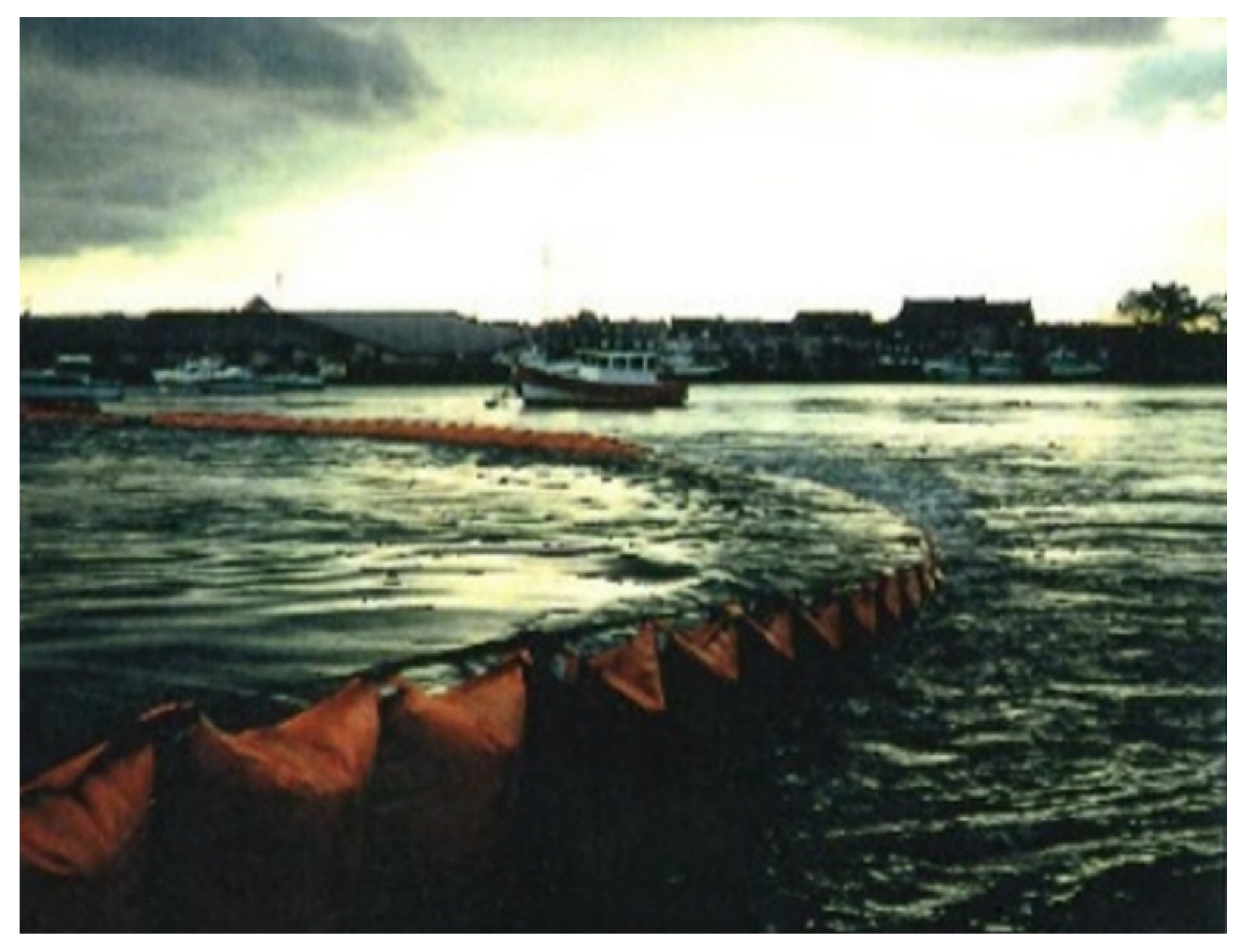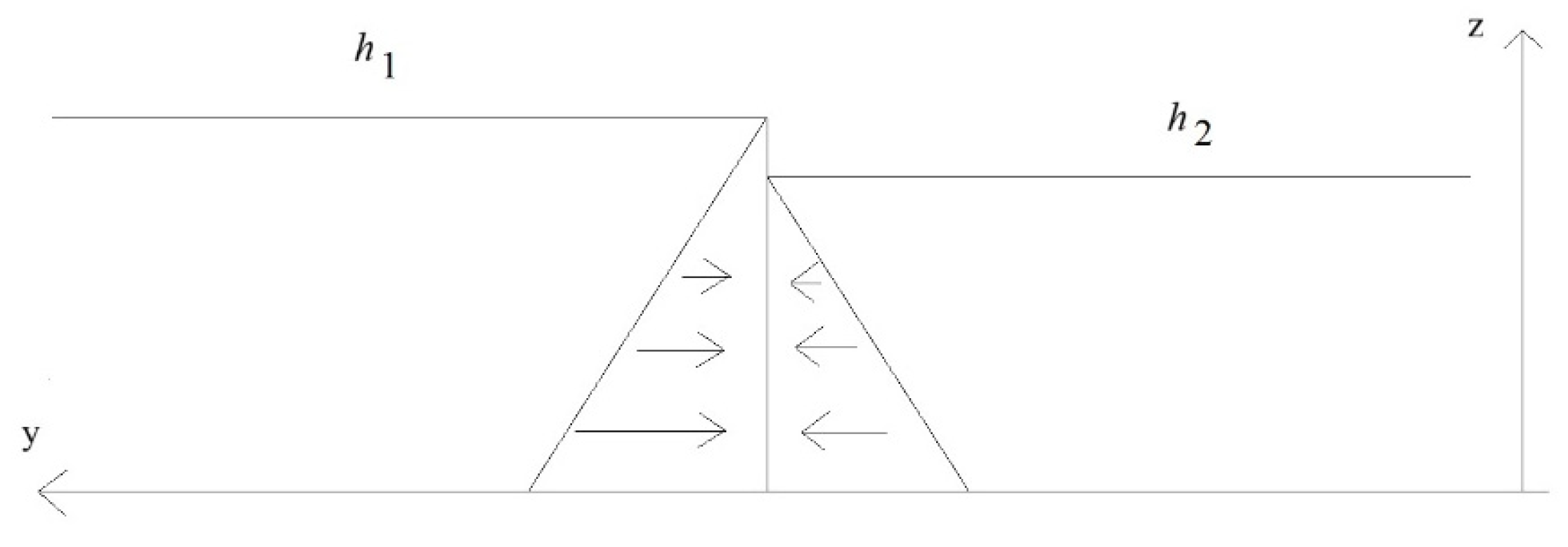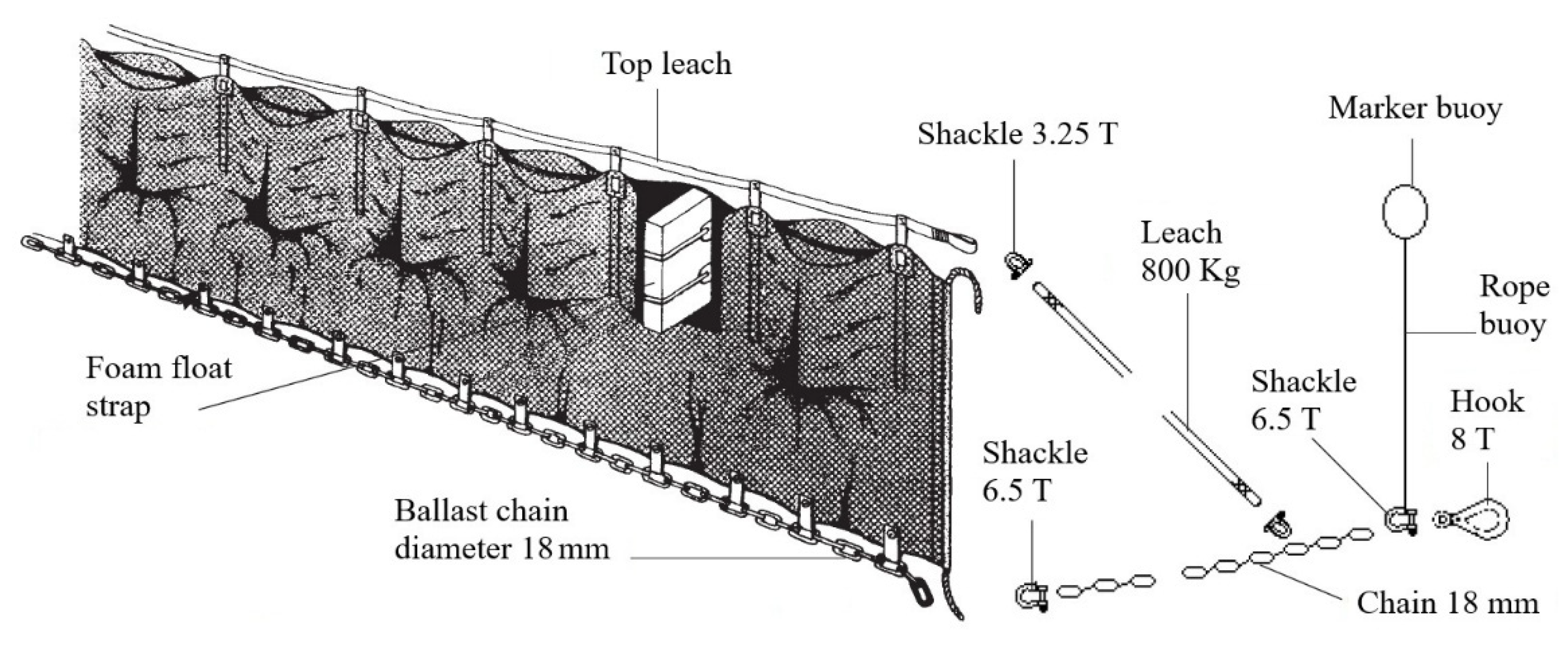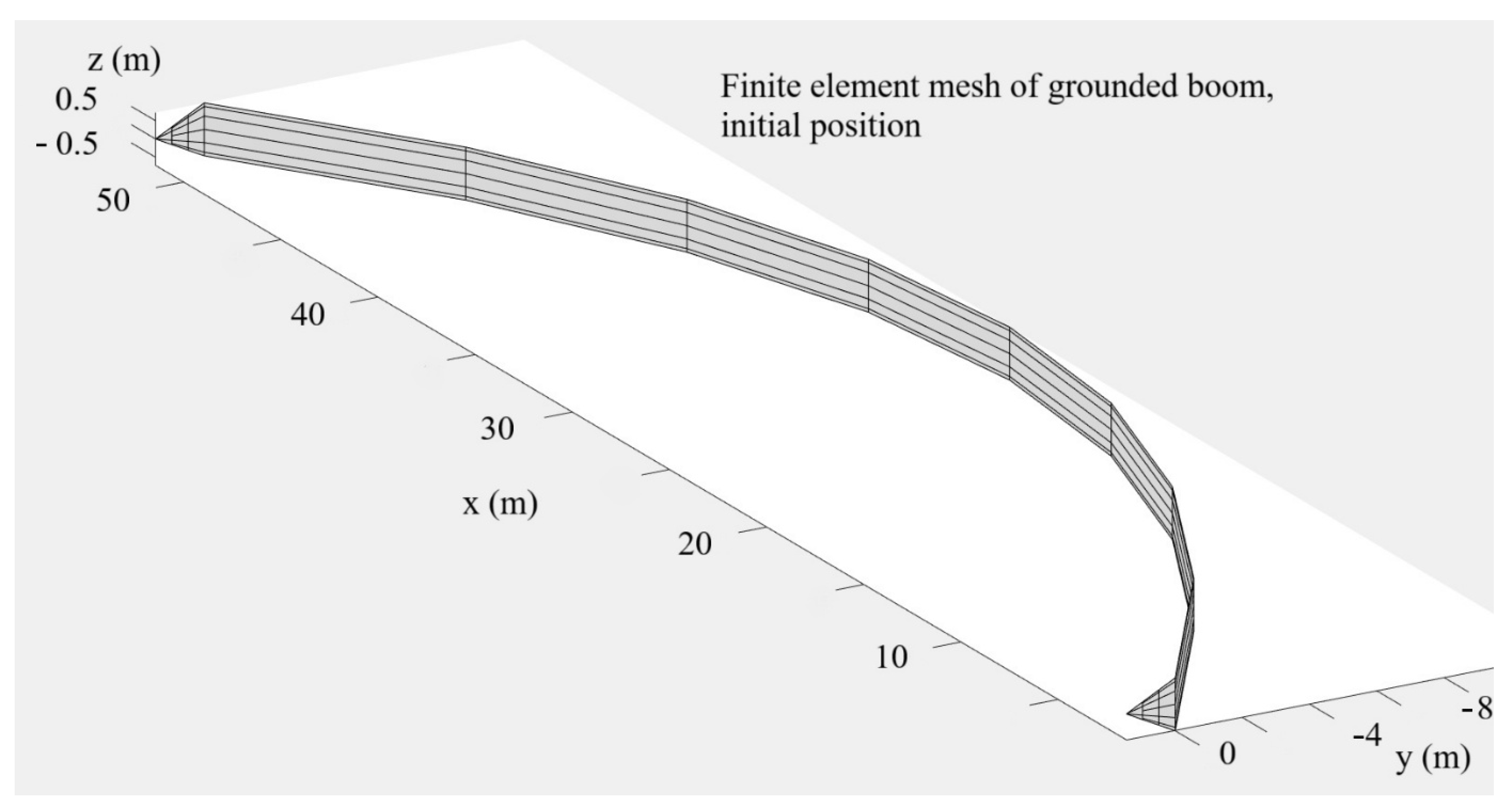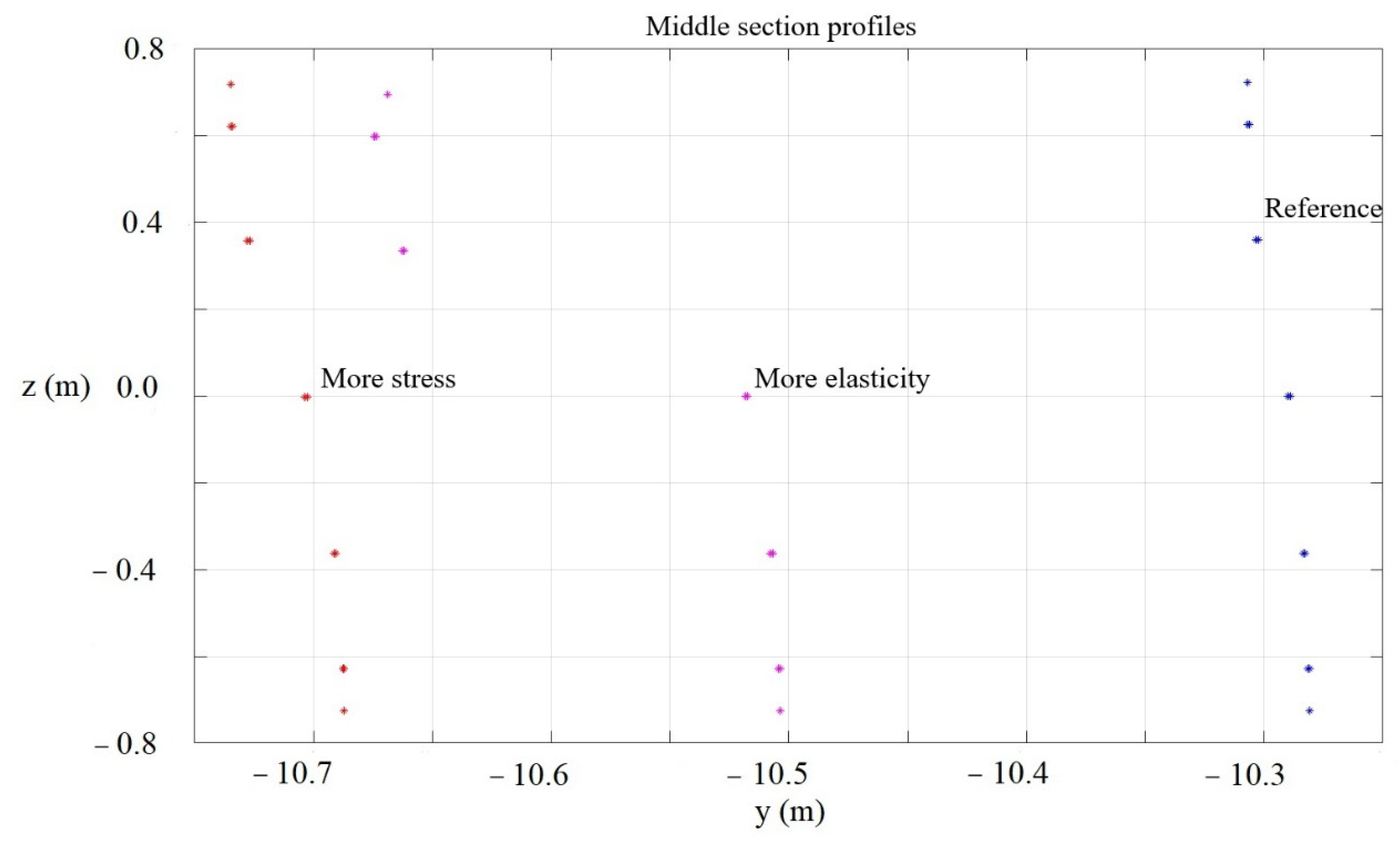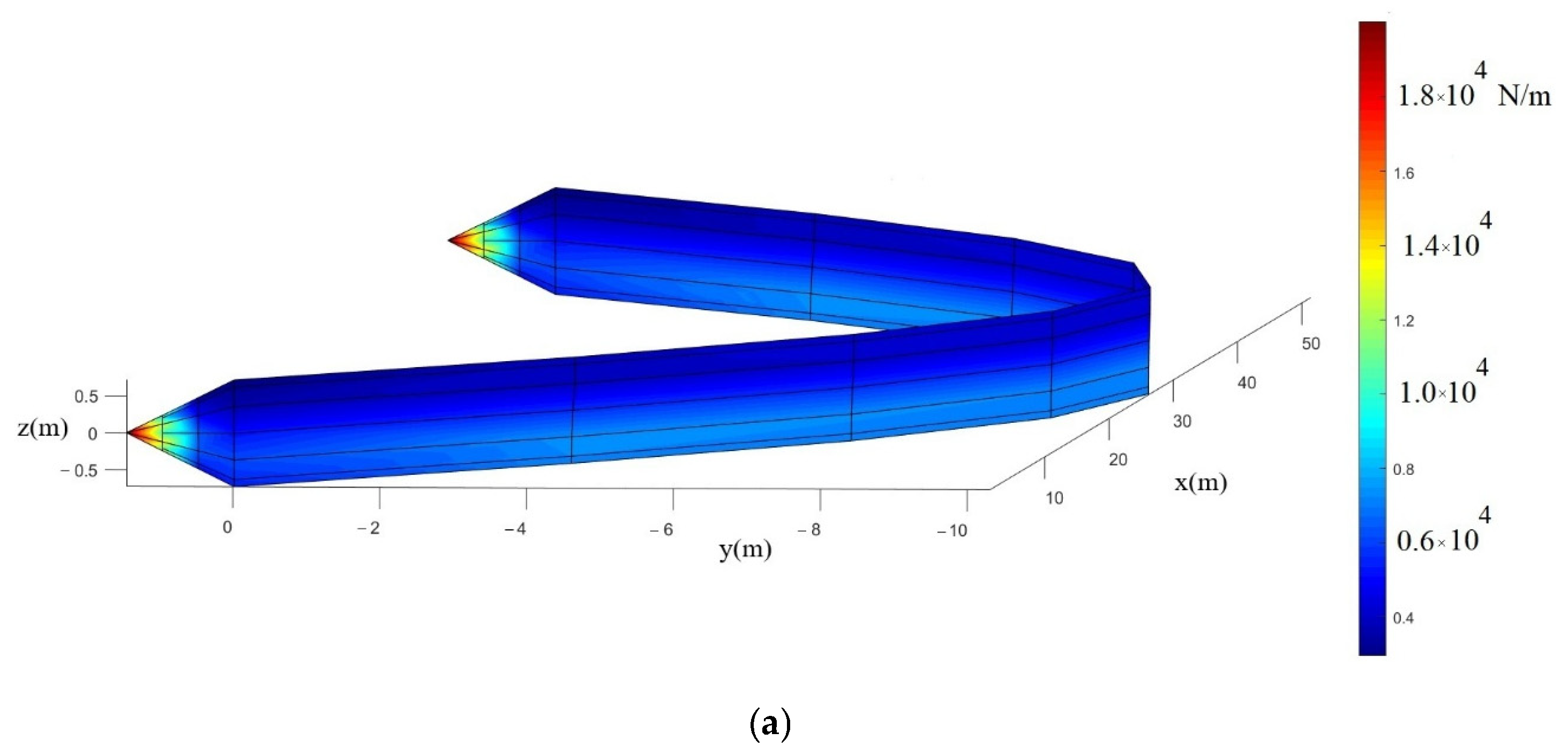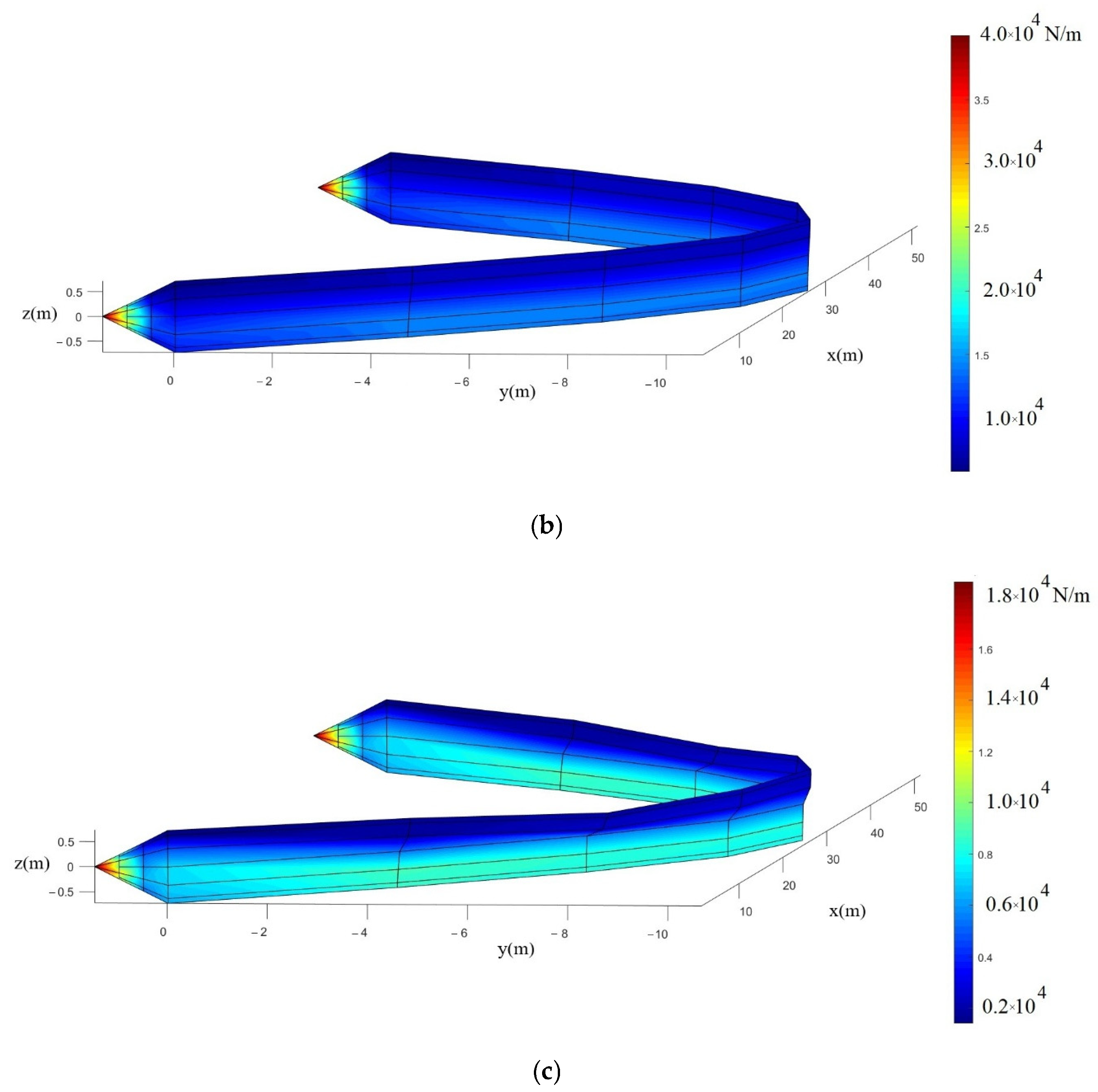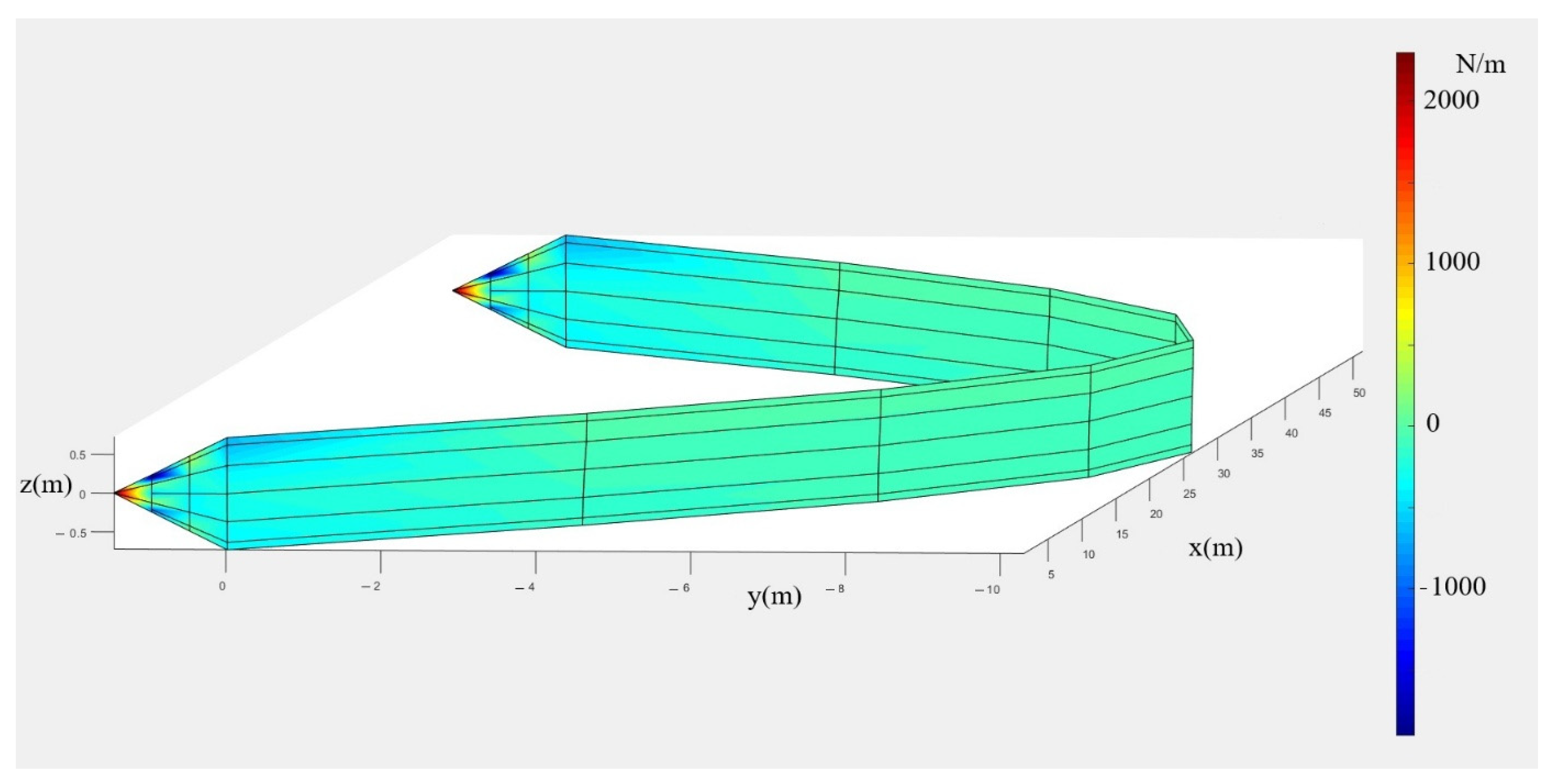1. Introduction
During hydrocarbon pollution events at sea, winds and currents influence the drift of pollutants and, therefore, the position of containment booms used to protect sensitive areas. During depth variations or tidal changes, grounding may occur, and buoyancy may decrease.
Figure 1, provided by the Pôle National d’Expertise POLlutions MARines, PNE POLMAR, shows a BALEAR 335 reference oil-spill boom in shallow water during a high-tide period. The grounding of the boom creates the appearance of a flexible dam [
1], a structure that retains water and sometimes generates a hydraulic jump at its center [
2,
3].
The overflow observed in
Figure 1 disrupts the containment of floating pollutants. Submarining is a result of additional sinkage, with the waterline being higher than expected. We note that, in open seas and under high current velocities, boom submarining with overflows can also be observed.
Our purpose is to estimate the large mooring forces observed in a grounded boom section in terms of water retention heights. We first consider hydrostatic mechanisms, which could provide flood protection with the use of inflatable barriers [
4].
To highlight our innovation, we review related studies.
Different boom designs exist [
5], but their mechanical principle remains the same. A perturbation develops on the free surface flow containing the oil, until an adverse effect occurs, such as an increasingly strong flow under the boom that draws the contained oil. Once the boom grounds, the flow under the boom ceases to exist, resulting in overflow and transversal flow.
Computational fluid dynamics is proposed to study the turbulence under single and double barriers [
6]. Different barrier drafts were considered, but the blocking of the whole water column is not addressed, and flows remain under the boom due to its conventional usage.
A specific design exists for booms deployed on seabeds. Shore-sealing booms are made of three tubes assembled in a triangular form [
7]. The two juxtaposed bottom tubes are ballasted with water, and the superposed tube is air-inflated. It can handle low tidal variations. An exercise conducted in the Palmonés estuary in the Bay of Algeciras, Spain, documented the use of a water-ballasted boom [
8], which provided mooring stiffness through weight-induced friction on a sandy beach.
Optimization problems [
9] aimed at minimizing protection costs in terms of spill damages are omitted here.
Physical containment using floating booms is a primary mechanical countermeasure for oil spills at sea. Booms have solid floats or are inflatable [
10]. The main goal of oil-spill response is to protect shorelines [
11]. Many studies have examined boom containment failures. Numerical models were used to predict oil containment failure in terms of boom draft [
12]. When water velocities increase, the smoothness of the water–oil interface decreases [
13]. The results are observed with respect to boom performances under wave and current coupling and with respect to contained oil thickness estimations. Moreover, numerical platforms were used to observe oil containment failure velocities, wave parameters, oil parameters, and boom drafts [
14]. Experimental and numerical simulations have been proposed for investigating oil containment motion and oil-stopping failure under wave–current coupling [
15]. Experiments in hydrodynamic channels and smoothed particle hydrodynamics (SPH) model simulations have been proposed to study failure modes in terms of current velocity [
16]. Rigid booms are considered under wave and current conditions using the computational fluid dynamics (CFD) software Ansys Fluent, v14.0 2011 [
17]. Fewer studies address structural boom analysis and fluid–structure interaction (FSI) methods. Deformable curvilinear beams [
18] and elastic membranes were considered [
19] as structural models. Rigid and flexible barriers were studied in a laboratory flume [
20] and with an FSI numerical approach [
21].
Using OpenFOAM v17.06 2020, novel boom concepts were studied in high-speed currents measuring
m.s
−1 instead of 0.51 m.s
−1 [
22].
Blocking the whole water column has been addressed using related technologies, such as silt curtains and turbidity barriers [
23]. The SPH method is used to assess water flux and wave actions, which could be supported.
Pollution throughout the entire water column has been studied, including cases such as dredging plumes in shallow water. A diagram was constructed to illustrate the spreading of dredging spills [
24]. Oceanographic moorings in cross-shore transects were deployed to study mud pollution at the Great Barrier Reef [
25]. Turbidity curtains or silt curtains [
26] are proposed for calm water conditions until currents of
m.s
−1. Hanging silt curtains are generally deployed to extend
m above the bottom, allowing mudflow to pass beneath them, while standing silt curtains block the whole water column. Curtain efficiency in crossflows has been analyzed both experimentally and numerically using an LES model [
27].
Remark 1: Our study does not contain CFD and FSI computations nor experiments at reduced scales. During the grounding reported in Figure 1, no fluid mechanics instruments, stress sensors, and underwater photographs were available. Consequently, the proposed structural computations will have no experimental validation. Numerical experiments exist for accidents [28] with crash-test validation. We interpret our study as a tentative numerical reconstitution of the structural behavior of the boom and moorings suggested in Figure 1. The boom grounding can be construed as a material accident during an oil spill. The context is the blocking of the water column by an oil-spill boom grounded on the seabed. This situation falls outside the normal usage of a boom used to contain oil pollution. The adverse effect is abnormal tension, which could displace moorings. To evaluate such mooring tension, we use membrane theory within the elastic domain and hydrostatic pressure in terms of free surface height differences between the upstream and downstream sides of the boom. This difference exhibits upstream water accumulation. Since this estimation is empirical, in a second test, we replace the hydrostatic load by a hydrodynamic one defined in terms of the horizontal sea current flowing toward the boom. We identify the current intensity, which provides the same mooring tension as that identified by hydrostatic water height differences. These dual loading approaches could result in better reliability.
We study the behavior of the boom and its mooring system, which are considered to be in a steady state, using an implicit 3D finite element method [
29,
30]. Hydrostatic forces will be evaluated empirically. Because the numerical computations used in hydrostatic forcings are defined a priori, in the second stage, we will consider hydrodynamic loadings to reach convergence between hydrostatic and hydrodynamic regimes.
The same mooring tension results from two forcing scenarios: hydrostatic forces generated by height differences and hydrodynamic forces from sea currents. Thus, we provide a better analysis of this non-conventional usage.
The high stiffness of the boom bottom and its ballast chain compared to the upper part is taken into account through the modulus of elasticity. We will consider the elasticity differentiation between the top half and the bottom half of the boom. The decrease in elastic rigidity in the upper part could favor the submarining of the boom and the appearance of an overflow.
The boom shown in
Figure 1 had a total height of 1.45 m, with an air draft of 0.58 m and a water draft of 0.87 m [
31]. In
Figure 1, we expect that the following three effects occur simultaneously: submarining, grounding, and stress on the seabed. The water depth at ebb tide may be less than the boom’s height. Three hypotheses regarding the skirt are considered: verticality, height close to the water depth, and hermetic contact with the seabed. A maximum force was applied to the boom.
The chosen boom is representative of one of the tallest skirts among all industrial references. We consider the specific dimensions of the boom to indicate problematic grounding issues to a maritime authority. The competent authority can require measures to prevent. Note that this situation can also occur in rivers. Currently, maritime authorities generally avoid boom usage when there is a risk of grounding [
32]. Additionally, the practice of sharing lessons learned from mooring and anchoring incidents has been established [
33].
Section 2 presents the theoretical and numerical models.
Section 3 describes the results concerning boom elasticity differentiation and the hydrostatic–hydrodynamic convergence.
Section 4 discusses the study’s limitations and generalizations.
3. Results
We study the structural elements and mooring structure of the BALEAR 335 boom shown in
Figure 4 [
31].
With 158 nodes and 156 finite elements, the mesh forms a double ribbon:
and
are connected along their top and bottom edges via the top leach and ballast chain. Quarter-turn floats can distribute load and lightly prestress the upper parts of
and
. Foam floats and their strap mechanisms are non-principal structural components and are not considered here. The double ribbon extends to two triangular shapes, representing end-sections with bridle mooring systems. The boom section measures
L = 50 m, as shown in
Figure 5.
Remark 2: The numerical simulation verifications use redundancy and symmetry. A double ribbon forms the finite element mesh. The displacement fields of the two ribbons are redundant. A symmetry along the x-axis exists in the numerical problem. A symmetry appears in the reaction forces between mooring hooks, bridles, and along the ballast chain.
3.1. Hydrostatic Convergence
The horizontal forcings are the hydrostatic pressures exerted by the water on the upstream and downstream sides of the boom [
42]. The density, thickness, and size of the upstream oil slick are not taken into account.
The material elasticity is assumed to be linear and isotropic, with different product values of Young’s modulus with respect to material thickness between the upper and lower halves of the boom. We integrate the high stiffness of the top leach and the very high stiffness of the ballast chain. A more in-depth study of elasticity would require distinguishing the modulus of elasticity of the chain, the top leach, and the envelopes of the floatation chambers.
We will consider an elasticity ratio between the bottom and top halves of 3.25/6.5 in the reference case and 0.8/6.5 for a softer material presented later. The values used in these ratios are derived from the failure limits of the chain, leach, and shackles, as shown in
Figure 4.
In our reference calculation, the modulus of elasticity by material thickness is 1 × 10
6 N/m for the lower half of the boom and 0.5 × 10
6 N/m for the upper part. The difference in hydrostatic pressure between the upstream and downstream sections corresponds to a water height,
, of 5 cm.
Figure 6 shows the shape of the vertical mid-section with dots in blue. The mid-section exhibits a curved shape. The z-coordinate of the top node tends to decrease.
The increase in the difference in water height to 10 cm accentuates the deformation of the boom, as shown by the red dots in
Figure 6. The decrease in the modulus of elasticity with respect to material thickness in the upper half to 1.23 × 10
5 N/m also accentuates the deformation, as shown by the magenta dots in
Figure 6.
The y-component of the tension at the two mooring nodes is given in
Table 1 for the reference calculation, along with two calculations assuming a parameter variation with respect to water height and the elasticity of the upper part.
Without bending stiffness, the membrane problem can result in a non-elliptic variational equation, where negative stress exists. Solutions can highlight wrinkles and numerical instability. By vertically blocking the boom bottom, Equation (5) reduces this effect.
For each of the three calculations, we indicate, in italics, the number of iterations required for the Newton–Raphson method to converge to machine precision, as shown via Equation (16). Less elasticity or larger efforts amplify strains and, thus, the number of iterations.
Let us consider a 1-ton-force (10 kN) mooring tension limit before sliding occurs. By using a simplified estimation [
43], this limit necessitates a 2485 kg dead-mass weight. Using a 6-ton highest-weighted mooring dead-mass, this results in a safety coefficient of 2.41. When dynamic loads are considered, the safety coefficient can be set to 7. Higher mooring chain lengths and dead-mass adherence on seabed substrates increase mooring safety. If a 1-ton mooring force limit is adopted, a 10 cm variation in water height can cause the boom mooring to exceed this threshold along the transversal y-component.
The oblong x-component mooring tension, which is higher than the y-component, is the tension transfer between adjacent boom sections. It acts on the adjacent mooring bridles in a multi-section boom plan. Its origin is a non-linear tension-leg effect [
29], which depends on the geometric curvature and particularly on the initial parabola depth of the boom section in the x-y plane. The deeper the parabola, the lower the x-component’s tension.
In
Table 2, we provide the z-coordinate of the mid-section’s top node for the reference calculation, as well as for two additional calculations with varying parameters with respect to hydrostatic pressure and the modulus of elasticity of the upper part. This coordinate is 0.725 m before deformation (initial value). Increased load and a lower modulus of elasticity cause submarining at the mid-section by a few centimeters.
The y-coordinate of the central top node is shown in
Table 3 for the reference calculation, as well as for the two parameter variations: hydrostatic pressure and modulus of elasticity of the upper part. This coordinate is −9.5164 m before deformation. This indicates the depth of the parabola that initiates the deformation. Lower modulus of elasticity and higher load promote elastic strain.
Figure 7 shows the first principal component of the stress tensor
σ(
u) for the reference calculation (
Figure 7a), with higher hydrostatic pressure (
Figure 7b), and with a lower modulus of elasticity in the upper part (
Figure 7c). In the latter case, the strain is accentuated. This reveals that submarining promotes a hydraulic jump. In the first two cases, the stress distributions are similar, and only the amplitude changes.
With higher water-level differences and lower elasticity in the upper part, submarining and overflow become important.
Figure 8 shows the minimal stress over the surface ω from the second eigenvalue of the stress tensor
σ. The minimal stress is low, allowing unidirectional principal stress along ω. Negative minimal stresses indicate wrinkles near the mooring bridle.
3.2. Hydrodynamic Convergence
One simulation is carried out as a hydrodynamic reference calculation with the following parameters: horizontal velocity amplitude of the current : 0.35 m.s−1; longitudinal drag coefficient C on the y-axis: 1.65. The velocity chosen corresponds to the practical limit used for oil-spill boom efficiency. The theoretical limit could be larger and depends on the oil density. The longitudinal drag coefficient was chosen with respect to the x-axis’s symmetry. It corresponds to a vertical z-axis boom section. We consider the boom elasticity of the previous hydrostatic reference calculation.
This study does not address the local effects on the hydrodynamic pressure
of the eventual two-phase (water-hydrocarbon) flow. A numerical analysis of this flow can compute the precise pressure. In 2DV, a flow stagnation area can be observed upstream near the seabed, where high pressure occurs. This effect decreases vertically toward the obstacle’s head [
44].
The first hypothesis assumes hydrostatic conditions for mooring tension calculations, and the second hypothesis assumes hydrodynamic conditions to estimate the same tension. The consequence of changing the hypothesis is reflected by comparing the mooring end-node tensions from two previous hydrostatic heights with those from the hydrodynamic cases. These values are summarized in
Table 4.
According to the hypothesis considered, we note the following mooring tension:
is hydrostatic for height differences of
, and
is hydrodynamic for current velocities of
. To determine which values of
and δ
h correspond to each other quantitatively, we will first associate them qualitatively. Small values of one correspond to small values of the other, and large values of one correspond with large values of the other. The approximations that
is linear in δℎ and
is linear in
permit the identification of
and δ
h, such as
Table 5 provides the qualitative associations and their
/
ratios. The rows describe the two hydrostatic calculations, and the columns describe the hydrodynamic case and its extrapolation at 0.7 m.s
−1.
The Froude number
Fr is defined by
In
Table 6, the Froude number associated with each component in
Table 5 is provided.
Hydrodynamic and hydrostatic convergence, where
/
in Equation (17) holds, can be observed in
Table 5. Since the y-axis hydrostatic mooring tension is linear in terms of δ
h, for a given velocity, the ratio
/
is inversely proportional to δ
h and thus depends linearly on
/δ
h. Consequently, for a given velocity, the quantity
/
remains constant. We note in column 1 of
Table 5 that 0.05∙0.38 = 0.1∙0.19, resulting in δ
h = 0.019 m and holding
/
at
= 0.35 m.s
−1. Another
/
convergence can be obtained. Column 2 of
Table 5 with
results in δ
h = 0.077 m for
= 0.7 m.s
−1.
Let us observe the rows of
Table 5. Since the y-axis mooring tension from a hydrodynamic source is proportional to the square
of the velocity amplitude
of the current, for a given δ
h, the ratio
/
is linear in terms of
. Two other
/
associations can be identified. For a 0.05 m height difference, we expect
/
for
= 0, 0.35, 0.7 m.s
−1 from the first line of
Table 5. The interpolation parabola of these three points takes the value of 1 for
= 0.566 m.s
−1. In the second row of
Table 5, a 0.1 m height difference results in
/
for
= 0, 0.35, 0.7 m.s
−1. The interpolation parabola of these three points takes the value of 1 for
= 0.797 m.s
−1.
Table 7 provides four hydrodynamic and hydrostatic forcing convergence cases, where
/
and Equation (17) holds and produces the related Froude number.
When the hydrostatic and hydrodynamic hypotheses converge, the Froude number tends toward 0.8 at higher values.
Let us consider a 6-ton dead-mass mooring [
43]. In the previous section, we studied a 1-ton mooring tension threshold and a 2.41 safety coefficient. We would like to determine up to what current velocity or water height difference (hydrostatic) the grounded boom studied above can be used without risking mooring slip. At a velocity of 0.35 m.s
−1 and a height of 0.019 m, the mooring tension’s x-y components are (4096, 3459) N. This is the only case in
Table 7 where the relation
/
holds, indicating that a 6-ton mooring weight can hold without slipping. A mooring weighting of 6-ton may slip at a velocity of 0.566 m.s
−1 and a height of 0.05 m. This case, as observed in
Table 7, reveals the mooring tension’s x-y components: (13,531, 9012) N.
4. Discussion
The limitations of this study arise from hydrodynamic, hydrostatic, and structural analysis perspectives.
We consider uniform hydrodynamic pressure along the vertical. Adding local effects on hydrodynamic pressure, vertical recirculation and horizontal eddies could improve the fluid problem’s definition.
The use of computational fluid dynamics (CFD) tools and experimental work would enable a 3D free surface flow study, providing upstream and downstream free surface positions with centimeter-level precision. A turbulence model would enhance the accuracy of current velocity predictions around the boom.
When the tide recedes and interrupts the flow between the boom’s bottom and the seabed, the boom begins to operate in a non-conventional manner. As grounding occurs, a thin layer of flow remains beneath the boom. This study could be extended to include wave action, which influences overflow. With vertical motion constrained by the seabed’s boundary, waves could promote the displacement of the oil pollutant.
A fluid structure interaction (FSI) model could deliver precise overflow and submarining calculations, revealing whether a steady state exists. This property could depend on boom elasticity, which is linear here with a high modulus. Inducing a steady state could ensure deployment and conception safety.
Sediment transport could cover the grounded boom skirt. More generally, grounded marine structures can become stuck in sediments. Future studies should address the significant impact of sediment type on the stability of buoyancy coffers. Operational guidelines play a key role in selecting the most suitable response and assessing the associated risks within anti-pollution plans.
We suggest a structural analysis of juxtaposed sorbent booms [
45]. These devices can be moved away from overflows. This study could be extended to improve oil recovery when pollutants drift longitudinally along the boom.
The limitations of this study with respect to the generalization of results are as follows. Reduced-scale experiments require dimensionless analysis, likely based on Froude similitude. For fluid mechanics alone, we suggest a mock-up in a flume tank. For solid mechanics, we consider it challenging to develop a thinner fabric material that simulates the role of elasticity in submarining—a role identified as one of the key findings of our study. Measuring fabric stress using a flexible sensor is challenging. Another result of our study indicates that the main stress is essentially longitudinal. This could simplify the solid mechanics perspective in the design of experiments. We also plan to extend this study to other floating pollutants and diluted contaminants in the water column.
